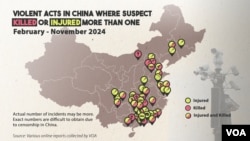Violent attacks in China this month have killed 43 people and injured more than 70, raising questions about why the tragic incidents occurred and sparking discussion and debate online.
VOA spoke with observers who see a link between the incidents and a lack of effective measures to address the underlying social and mental health issues caused, in part, by the country’s current economic challenges.
“These violent attacks happen quite frequently, and one cause of the attacks is China’s sluggish economy and the direct grievances that it creates for average people across several industries and social classes,” said Kevin Slaten, the research lead of the China Dissent Monitor project under Washington-based Freedom House.
In Slaten’s view, widespread grievances caused by China’s economic downturn not only caused worker protests in China but may also have forced some people to adopt more extreme measures to express their feeling of desperation. While some violent acts seem to be random, others are directed at a person or people known to the suspect.
“There are more incidents of unpaid wages toward the end of the year, and these things not only drive protests but also drive individual frustration, anger and hopelessness that leads some people to take it out through senseless violence,” Slaten said in a phone interview.
In one of the most recent attacks, a 21-year-old student in the city of Wuxi, in eastern China, was reportedly so dissatisfied with his pay at an internship that he killed eight people and injured 17 more with a knife at a vocational school on November 16.
In another case, a 29-year-old man rammed a car into a group of people at a factory in southeastern China’s Guangdong Province in August due to labor disputes. He injured at least eight people.
Slaten said there are mechanisms designed to address grievances over pay and other issues in China, but Chinese people often are unable to resolve their problems through these channels.
“It’s difficult to bring collective cases under China’s court system, and court cases often take a long time, so for vulnerable communities that don’t have the time or resources to deal with the court system, they can’t rely on it,” Slaten said.
In his view, while some Chinese citizens will try to highlight their cases through public advocacy, “anger and desperation could motivate mass violence too.”
Some experts say working-class people are often the group affected the most by China’s ongoing economic downturn.
“For hundreds of millions of migrant workers, there is not an adequate social safety net, and things like unemployment insurance are not really in place,” Eli Friedman, a professor at Cornell University’s School of Industrial and Labor Relations, told VOA by phone.
An existing trend
VOA researched online reports of violent attacks in China between February and November of this year in which more than one person was killed or injured. Combined, some 120 people were killed and more than 213 were injured in those attacks.
November marks the deadliest month in China.
VOA’s data analysis shows knives were used in most of the attacks. Vehicles directed at people were also used.
Since information about the attacks is often instantly removed from social media platforms by Chinese authorities, it can be difficult to understand the motives of the attackers or the scale and frequency of the incidents.
Experts say Chinese authorities want to prevent information about violent attacks from spreading in society. Soon after each event, the government will try to censor discussions on social media platforms related to the incidents, said Dali Yang, an expert on Chinese politics at the University of Chicago.
“They don’t want other people to think this is something to resort to if they can’t express their grievances, but such actions also make it very difficult for authorities to understand the underlying causes of such cases, resulting in their failure to address these causes,” Yang told VOA by phone.
When VOA tried to search for posts about the car-ramming incident in Zhuhai on China’s microblogging site Weibo, which is similar to social media platform X, no relevant results were found.
Despite Chinese authorities’ efforts to limit the spread of information about these attacks, Yang said, Chinese citizens are still expressing concerns about the surge of random acts of violence.
“Even without much information, I do get a sense in chat rooms on messaging apps that there is anxiety about these attacks in China. Part of the reason is because these are indiscriminate attacks happening in places with a lot of people,” he told VOA.
Chinese government’s response
Following the attack in Zhuhai, President Xi Jinping urged relevant authorities to “strengthen their prevention and control of risks at the source” and “emphasized the importance of resolving disputes in time.”
China’s top prosecutorial office also pledged “stern, strict and swift punishment for major vicious crimes to maintain social stability” and reiterated its “zero-tolerance approach toward crimes targeting students and compromising school safety.”
Local media reports revealed that some local authorities in China have started to identify specific types of high-risk individuals who might carry out indiscriminate violent attacks against the public. These include the unemployed, people who have recently ended relationships, people with low incomes and those with no channels to express their feelings.
China’s basic medical insurance for city dwellers and guaranteed minimum living standards for rural residents usually provide subsidies to individuals who fit the high-risk criteria, analysts said. However, the economic downturn and lack of financial resources may make it difficult for the Chinese government to maintain these social programs.
“Their measures to identify individuals who are at risk of carrying out violent attacks against the public may be a short-term strategy to deal with social discontent, and it remains to be seen whether they resort to more repressive measures, such as using centralized ways to manage these individuals,” Lin Thung-Hong, a research fellow at the Academia Sinica in Taiwan, told VOA.

